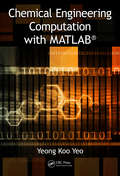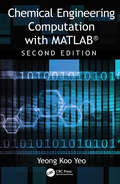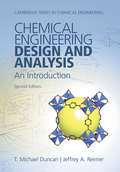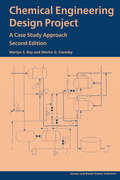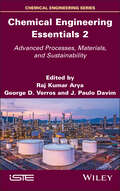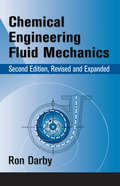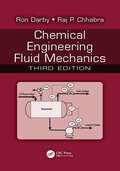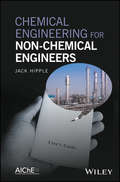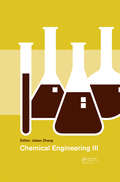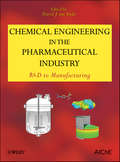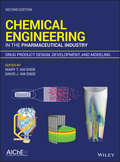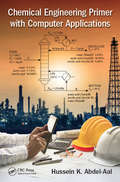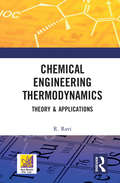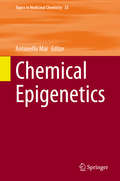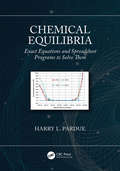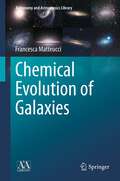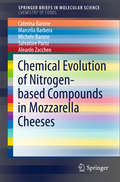- Table View
- List View
Chemical Engineering Computation with MATLAB
by Yeong Koo Yeo<p>Most problems encountered in chemical engineering are sophisticated and interdisciplinary. Thus, it is important for today’s engineering students, researchers, and professionals to be proficient in the use of software tools for problem solving. MATLAB® is one such tool that is distinguished by the ability to perform calculations in vector-matrix form, a large library of built-in functions, strong structural language, and a rich set of graphical visualization tools. Furthermore, MATLAB integrates computations, visualization and programming in an intuitive, user-friendly environment. <p>Chemical Engineering Computation with MATLAB® presents basic to advanced levels of problem-solving techniques using MATLAB as the computation environment. The book provides examples and problems extracted from core chemical engineering subject areas and presents a basic instruction in the use of MATLAB for problem solving. It provides many examples and exercises and extensive problem-solving instruction and solutions for various problems. Solutions are developed using fundamental principles to construct mathematical models and an equation-oriented approach is used to generate numerical results. <p>A wealth of examples demonstrate the implementation of various problem-solving approaches and methodologies for problem formulation, problem solving, analysis, and presentation, as well as visualization and documentation of results. This book also provides aid with advanced problems that are often encountered in graduate research and industrial operations, such as nonlinear regression, parameter estimation in differential systems, two-point boundary value problems and partial differential equations and optimization.</p>
Chemical Engineering Computation with MATLAB®
by Yeong Koo YeoChemical Engineering Computation with MATLAB®, Second Edition continues to present basic to advanced levels of problem-solving techniques using MATLAB as the computation environment. The Second Edition provides even more examples and problems extracted from core chemical engineering subject areas and all code is updated to MATLAB version 2020. It also includes a new chapter on computational intelligence and: Offers exercises and extensive problem-solving instruction and solutions for various problems Features solutions developed using fundamental principles to construct mathematical models and an equation-oriented approach to generate numerical results Delivers a wealth of examples to demonstrate the implementation of various problem-solving approaches and methodologies for problem formulation, problem solving, analysis, and presentation, as well as visualization and documentation of results Includes an appendix offering an introduction to MATLAB for readers unfamiliar with the program, which will allow them to write their own MATLAB programs and follow the examples in the book Provides aid with advanced problems that are often encountered in graduate research and industrial operations, such as nonlinear regression, parameter estimation in differential systems, two-point boundary value problems and partial differential equations and optimization This essential textbook readies engineering students, researchers, and professionals to be proficient in the use of MATLAB to solve sophisticated real-world problems within the interdisciplinary field of chemical engineering. The text features a solutions manual, lecture slides, and MATLAB program files._
Chemical Engineering Design and Analysis: An Introduction (Cambridge Series in Chemical Engineering)
by T. Michael Duncan Jeffrey A. ReimerThis textbook puts design at the center of introducing students to the course in mass and energy balances in chemical engineering. Employers and accreditations increasingly stress the importance of design in the engineering curriculum, and design-driven analysis will motivate students to dig deeply into the key concepts of the field. The second edition has been completely revised and updated. It introduces the central steps in design and three methods of analysis: mathematical modeling, graphical methods, and dimensional analysis. Students learn how to apply engineering skills, such as how to simplify calculations through assumptions and approximations; how to verify calculations, significant figures, spreadsheets, graphing (standard, semi-log and log-log); and how to use data maps, in the contexts of contemporary chemical processes such as the hydrogen economy, petrochemical and biochemical processes, polymers, semiconductors, and pharmaceuticals.
Chemical Engineering Design and Analysis
by T. Michael Duncan Jeffrey A. ReimerStudents taking their first chemical engineering course plunge into the "nuts and bolts" of mass and energy balances, often missing the broad view of what chemical engineers do. This innovative text offers a well-paced introduction to chemical engineering. The text helps students practice engineering. They are introduced to the fundamental steps in design and three methods of analysis: mathematical modeling, graphical methods, and dimensional analysis. In addition, students apply engineering skills, such as how to simplify calculations through assumptions and approximations; how to verify calculations, significant figures, spreadsheets, graphing (standard, semi-log and log-log); and how to use data maps. It also describes the chemical engineering profession. Students learn engineering skills by designing and analyzing chemical processes and process units in order to assess product quality, economics, safety, and environmental impact. This text will help students develop engineering skills early in their studies and encourage an informed decision of whether to study chemical engineering. Solutions manual available.
Chemical Engineering Design Project: A Case Study Approach, Second Edition
by Martyn S RayThis new edition follows the original format, which combines a detailed case study - the production of phthalic anhydride - with practical advice and comprehensive background information. Guiding the reader through all major aspects of a chemical engineering design, the text includes both the initial technical and economic feasibility study as well as the detailed design stages. Each aspect of the design is illustrated with material from an award-winning student design project. The book embodies the "learning by doing" approach to design. The student is directed to appropriate information sources and is encouraged to make decisions at each stage of the design process rather than simply following a design method. Thoroughly revised, updated, and expanded, the accompanying text includes developments in important areas and many new references.
Chemical Engineering Essentials, Volume 2: Advanced Processes, Materials, and Sustainability (ISTE Invoiced)
by Raj Kumar Arya George D. Verros J. Paulo DavimIn an era of rapid innovation and with a focus on sustainability, Chemical Engineering Essentials provides a definitive guide to mastering the discipline. Divided into two volumes, this series offers a seamless blend of foundational knowledge and advanced applications to address the evolving needs of academia and industry. Volume 1 lays a strong foundation with topics such as material and energy balances, thermodynamics, phase equilibrium, fluid mechanics, transport phenomena, and essential separation processes such as distillation and membrane technologies. This volume builds on these principles, delving into reaction engineering, reactor modeling with MATLAB and ASPEN PLUS, material properties, process intensification and nanotechnology. It also addresses critical global challenges, emphasizing green chemistry, waste minimization, resource recovery, and workplace safety. Together, these volumes provide a holistic understanding of chemical engineering, equipping readers with the tools to innovate and lead in a dynamic and sustainable future.
Chemical Engineering Fluid Mechanics (Second Edition)
by Ronald Darby Ron Darby Raj P. ChhabraCombining comprehensive theoretical and empirical perspectives into a clearly organized text, Chemical Engineering Fluid Mechanics, Second Edition discusses the principal behavioral concepts of fluids and the basic methods of analysis for resolving a variety of engineering situations. Drawing on the author's 35 years of experience, the book covers real-world engineering problems and concerns of performance, equipment operation, sizing, and selection from the viewpoint of a process engineer. It supplies over 1500 end-of-chapter problems, examples, equations, literature references, illustrations, and tables to reinforce essential concepts.
Chemical Engineering Fluid Mechanics, Third Edition
by Raj P. Chhabra Ron DarbyThis book provides readers with the most current, accurate, and practical fluid mechanics related applications that the practicing BS level engineer needs today in the chemical and related industries, in addition to a fundamental understanding of these applications based upon sound fundamental basic scientific principles. The emphasis remains on problem solving, and the new edition includes many more examples.
Chemical Engineering for Non-Chemical Engineers
by Jack HippleOutlines the concepts of chemical engineering so that non-chemical engineers can interface with and understand basic chemical engineering concepts
Chemical Engineering III
by Jiatao ZhangChemical Engineering III includes the proceedings of the 3rd SREE Conference on Chemical Engineering (CCE 2013, Hong Kong, 28-29 December 2013) and the 2nd SREE Workshop on Energy, Environment and Engineering (WEEE 2013, which was a part of CCE 2013). The contributions discuss current practical challenges and solutions in Chemical Engineering, and
Chemical Engineering in the Pharmaceutical Industry
by David J. am EndeThis book deals with various unique elements in the drug development process within chemical engineering science and pharmaceutical R&D. The book is intended to be used as a professional reference and potentially as a text book reference in pharmaceutical engineering and pharmaceutical sciences. Many of the experimental methods related to pharmaceutical process development are learned on the job. This book is intended to provide many of those important concepts that R&D Engineers and manufacturing Engineers should know and be familiar if they are going to be successful in the Pharmaceutical Industry. These include basic analytics for quantitation of reaction components- often skipped in ChE Reaction Engineering and kinetics books. In addition Chemical Engineering in the Pharmaceutical Industry introduces contemporary methods of data analysis for kinetic modeling and extends these concepts into Quality by Design strategies for regulatory filings. For the current professionals, in-silico process modeling tools that streamline experimental screening approaches is also new and presented here. Continuous flow processing, although mainstream for ChE, is unique in this context given the range of scales and the complex economics associated with transforming existing batch-plant capacity.The book will be split into four distinct yet related parts. These parts will address the fundamentals of analytical techniques for engineers, thermodynamic modeling, and finally provides an appendix with common engineering tools and examples of their applications.
Chemical Engineering in the Pharmaceutical Industry: Drug Product Design, Development, and Modeling
by Mary T. am Ende David J. am EndeA guide to the important chemical engineering concepts for the development of new drugs, revised second edition The revised and updated second edition of Chemical Engineering in the Pharmaceutical Industry offers a guide to the experimental and computational methods related to drug product design and development. The second edition has been greatly expanded and covers a range of topics related to formulation design and process development of drug products. The authors review basic analytics for quantitation of drug product quality attributes, such as potency, purity, content uniformity, and dissolution, that are addressed with consideration of the applied statistics, process analytical technology, and process control. The 2nd Edition is divided into two separate books: 1) Active Pharmaceutical Ingredients (API’s) and 2) Drug Product Design, Development and Modeling. The contributors explore technology transfer and scale-up of batch processes that are exemplified experimentally and computationally. Written for engineers working in the field, the book examines in-silico process modeling tools that streamline experimental screening approaches. In addition, the authors discuss the emerging field of continuous drug product manufacturing. This revised second edition: Contains 21 new or revised chapters, including chapters on quality by design, computational approaches for drug product modeling, process design with PAT and process control, engineering challenges and solutions Covers chemistry and engineering activities related to dosage form design, and process development, and scale-up Offers analytical methods and applied statistics that highlight drug product quality attributes as design features Presents updated and new example calculations and associated solutions Includes contributions from leading experts in the field Written for pharmaceutical engineers, chemical engineers, undergraduate and graduation students, and professionals in the field of pharmaceutical sciences and manufacturing, Chemical Engineering in the Pharmaceutical Industry, Second Edition contains information designed to be of use from the engineer's perspective and spans information from solid to semi-solid to lyophilized drug products.
Chemical Engineering in the Pharmaceutical Industry, Active Pharmaceutical Ingredients: R And D To Manufacturing
by David J. am Ende Mary T. am EndeA guide to the development and manufacturing of pharmaceutical products written for professionals in the industry, revised second edition The revised and updated second edition of Chemical Engineering in the Pharmaceutical Industry is a practical book that highlights chemistry and chemical engineering. The book’s regulatory quality strategies target the development and manufacturing of pharmaceutically active ingredients of pharmaceutical products. The expanded second edition contains revised content with many new case studies and additional example calculations that are of interest to chemical engineers. The 2nd Edition is divided into two separate books: 1) Active Pharmaceutical Ingredients (API’s) and 2) Drug Product Design, Development and Modeling. The active pharmaceutical ingredients book puts the focus on the chemistry, chemical engineering, and unit operations specific to development and manufacturing of the active ingredients of the pharmaceutical product. The drug substance operations section includes information on chemical reactions, mixing, distillations, extractions, crystallizations, filtration, drying, and wet and dry milling. In addition, the book includes many applications of process modeling and modern software tools that are geared toward batch-scale and continuous drug substance pharmaceutical operations. This updated second edition: • Contains 30new chapters or revised chapters specific to API, covering topics including: manufacturing quality by design, computational approaches, continuous manufacturing, crystallization and final form, process safety • Expanded topics of scale-up, continuous processing, applications of thermodynamics and thermodynamic modeling, filtration and drying • Presents updated and expanded example calculations • Includes contributions from noted experts in the field Written for pharmaceutical engineers, chemical engineers, undergraduate and graduate students, and professionals in the field of pharmaceutical sciences and manufacturing, the second edition of Chemical Engineering in the Pharmaceutical Industry focuses on the development and chemical engineering as well as operations specific to the design, formulation, and manufacture of drug substance and products.
Chemical Engineering in the Pharmaceutical Industry, Active Pharmaceutical Ingredients: R And D To Manufacturing
by David J. am Ende Mary T. am EndeA guide to the development and manufacturing of pharmaceutical products written for professionals in the industry, revised second edition The revised and updated second edition of Chemical Engineering in the Pharmaceutical Industry is a practical book that highlights chemistry and chemical engineering. The book’s regulatory quality strategies target the development and manufacturing of pharmaceutically active ingredients of pharmaceutical products. The expanded second edition contains revised content with many new case studies and additional example calculations that are of interest to chemical engineers. The 2nd Edition is divided into two separate books: 1) Active Pharmaceutical Ingredients (API’s) and 2) Drug Product Design, Development and Modeling. The active pharmaceutical ingredients book puts the focus on the chemistry, chemical engineering, and unit operations specific to development and manufacturing of the active ingredients of the pharmaceutical product. The drug substance operations section includes information on chemical reactions, mixing, distillations, extractions, crystallizations, filtration, drying, and wet and dry milling. In addition, the book includes many applications of process modeling and modern software tools that are geared toward batch-scale and continuous drug substance pharmaceutical operations. This updated second edition: • Contains 30new chapters or revised chapters specific to API, covering topics including: manufacturing quality by design, computational approaches, continuous manufacturing, crystallization and final form, process safety • Expanded topics of scale-up, continuous processing, applications of thermodynamics and thermodynamic modeling, filtration and drying • Presents updated and expanded example calculations • Includes contributions from noted experts in the field Written for pharmaceutical engineers, chemical engineers, undergraduate and graduate students, and professionals in the field of pharmaceutical sciences and manufacturing, the second edition of Chemical Engineering in the Pharmaceutical Industry focuses on the development and chemical engineering as well as operations specific to the design, formulation, and manufacture of drug substance and products.
Chemical Engineering Primer with Computer Applications
by Hussein K. Abdel-AalTaking a highly pragmatic approach to presenting the principles and applications of chemical engineering, this companion text for students and working professionals offers an easily accessible guide to solving problems using computers. The primer covers the core concepts of chemical engineering, from conservation laws all the way up to chemical kinetics, without heavy stress on theory and is designed to accompany traditional larger core texts. The book presents the basic principles and techniques of chemical engineering processes and helps readers identify typical problems and how to solve them. Focus is on the use of systematic algorithms that employ numerical methods to solve different chemical engineering problems by describing and transforming the information. Problems are assigned for each chapter, ranging from simple to difficult, allowing readers to gradually build their skills and tackle a broad range of problems. MATLAB and Excel® are used to solve many examples and the more than 70 real examples throughout the book include computer or hand solutions, or in many cases both. The book also includes a variety of case studies to illustrate the concepts and a downloadable file containing fully worked solutions to the book’s problems on the publisher’s website. Introduces the reader to chemical engineering computation without the distractions caused by the contents found in many texts. Provides the principles underlying all of the major processes a chemical engineer may encounter as well as offers insight into their analysis, which is essential for design calculations. Shows how to solve chemical engineering problems using computers that require numerical methods using standard algorithms, such as MATLAB® and Excel®. Contains selective solved examples of many problems within the chemical process industry to demonstrate how to solve them using the techniques presented in the text. Includes a variety of case studies to illustrate the concepts and a downloadable file containing fully worked solutions to problems on the publisher’s website. Offers non-chemical engineers who are expected to work with chemical engineers on projects, scale-ups and process evaluations a solid understanding of basic concepts of chemical engineering analysis, design, and calculations.
Chemical Engineering Principles and Applications
by Nuggenhalli S. NandagopalThis text provides a clear and concise understanding of the principles and applications of chemical engineering using a rigorous, yet easy-to-follow, presentation. The coverage is broad, and it includes all the relevant concepts such as mass and energy balances, mass transfer, chemical reaction engineering, and many more. Elucidation of the principles is further reinforced by examples and practice problems with detailed solutions. Firmly grounded in the fundamentals, the book maximizes readers’ capacity to take on new problems and challenges in the field with confidence and conviction. Providing a ready reference and review of essential principles and their applications in chemical engineering, the book is ideal for undergraduate chemical engineering students, as well as practicing engineers preparing for the engineering license exams (FE and PE) in USA and abroad.
Chemical Engineering Thermodynamics: Theory & Applications
by R. RaviThe book presents concepts and equations of equilibrium thermodynamics or thermostatics. Key features that distinguish this book from others on chemical engineering thermodynamics are: a mathematical treatment of the developments leading to the discovery of the internal energy and entropy; a clear distinction between the classical thermodynamics of Carnot, Clausius and Kelvin and the thermostatics of Gibbs; an intensive/specific variable formalism from which the extensive variable formalism is obtained as a special case; a systematic method of obtaining the central equations of thermostatics with the use of the implicit/inverse function theorems and the chain rule. Please note: Taylor & Francis does not sell or distribute the Hardback in India, Pakistan, Nepal, Bhutan, Bangladesh and Sri Lanka.
Chemical Epigenetics (Topics in Medicinal Chemistry #33)
by Antonello MaiThis book presents an authoritative review of the most significant findings about all the epigenetic targets (writers, readers, and erasers) and their implication in physiology and pathology. The book also covers the design, synthesis and biological validation of epigenetic chemical modulators, which can be useful as novel chemotherapeutic agents. Particular attention is given to the chemical mechanisms of action of these molecules and to the drug discovery prose which allows their identification. This book will appeal to students who want to know the extensive progresses made by epigenetics (targets and modulators) in the last years from the beginning, and to specialized scientists who need an instrument to quickly search and check historical and/or updated notices about epigenetics.
Chemical Equilibria: Exact Equations and Spreadsheet Programs to Solve Them
by Harry L. PardueConcepts, procedures and programs described in this book make it possible for readers to solve both simple and complex equilibria problems quickly and easily and to visualize results in both numerical and graphical forms. They allow the user to calculate concentrations of reactants and products for both simple and complicated situations. The user can spend less time doing calculations and more time thinking about what the results mean in terms of a larger problem in which she or he may be interested.
Chemical Equilibria
by Michel SoustelleThe book offers advanced students, in 7 volumes, successively characterization tools phases, the study of all types of phase, liquid, gas and solid, pure or multi-component, process engineering, chemical and electrochemical equilibria, the properties of surfaces and phases of small sizes. Macroscopic and microscopic models are in turn covered with a constant correlation between the two scales. Particular attention was given to the rigor of mathematical developments. Besides some very specialized books, the vast majority of existing works are intended for beginners and therefore limited in scope. There is no obvious connection between the two categories of books, general books does not go far enough in generalizing concepts to enable easy reading of advanced literature. The proposed project aims to give readers the ability to read highly specialized publications based on a more general presentation of the different fields of chemical thermodynamics. Consistency is ensured between the basic concepts and applications. So we find, in the same work, the tools, their use and comparison, for a more general macroscopic description and a microscopic description of a phase.
Chemical Equilibria
by Michel SoustelleThe book offers advanced students, in 7 volumes, successively characterization tools phases, the study of all types of phase, liquid, gas and solid, pure or multi-component, process engineering, chemical and electrochemical equilibria, the properties of surfaces and phases of small sizes. Macroscopic and microscopic models are in turn covered with a constant correlation between the two scales. Particular attention was given to the rigor of mathematical developments. Besides some very specialized books, the vast majority of existing works are intended for beginners and therefore limited in scope. There is no obvious connection between the two categories of books, general books does not go far enough in generalizing concepts to enable easy reading of advanced literature. The proposed project aims to give readers the ability to read highly specialized publications based on a more general presentation of the different fields of chemical thermodynamics. Consistency is ensured between the basic concepts and applications. So we find, in the same work, the tools, their use and comparison, for a more general macroscopic description and a microscopic description of a phase.
Chemical Equilibria in Analytical Chemistry: The Theory of Acid–Base, Complex, Precipitation and Redox Equilibria
by Fritz Scholz Heike KahlertThis book provides a modern and easy-to-understand introduction to the chemical equilibria in solutions. It focuses on aqueous solutions, but also addresses non-aqueous solutions, covering acid–base, complex, precipitation and redox equilibria. The theory behind these and the resulting knowledge for experimental work build the foundations of analytical chemistry. They are also of essential importance for all solution reactions in environmental chemistry, biochemistry and geochemistry as well as pharmaceutics and medicine. Each chapter and section highlights the main aspects, providing examples in separate boxes. Questions and answers are included to facilitate understanding, while the numerous literature references allow students to easily expand their studies.
Chemical Evolution: The Biological System of the Elements
by Stefan Fränzle Bernd Markert Simone WünschmannThis book is written for researchers and students interested in the function and role of chemical elements in biological or environmental systems. Experts have long known that the Periodic System of Elements (PSE) provides only an inadequate chemical description of elements of biological, environmental or medicinal importance. This book explores the notion of a Biological System of the Elements (BSE) established on accurate and precise multi-element data, including evolutionary aspects, representative sampling procedures, inter-element relationships, the physiological function of elements and uptake mechanisms. The book further explores the concept Stoichiometric Network Analysis (SNA) to analyze the biological roles of chemical species. Also discussed is the idea of ecotoxicological identity cards which give a first-hand description of properties relevant for biological and toxicological features of a certain chemical element and its geo biochemically plausible speciation form. The focus of this book goes beyond both classical bioinorganic chemistry and toxicology.
Chemical Evolution of Galaxies (Astronomy and Astrophysics Library #253)
by Francesca MatteucciThe term "chemical evolution of galaxies" refers to the evolution of abundances of chemical species in galaxies, which is due to nuclear processes occurring in stars and to gas flows into and out of galaxies. This book deals with the chemical evolution of galaxies of all morphological types (ellipticals, spirals and irregulars) and stresses the importance of the star formation histories in determining the properties of stellar populations in different galaxies. The topic is approached in a didactical and logical manner via galaxy evolution models which are compared with observational results obtained in the last two decades: The reader is given an introduction to the concept of chemical abundances and learns about the main stellar populations in our Galaxy as well as about the classification of galaxy types and their main observables. In the core of the book, the construction and solution of chemical evolution models are discussed in detail, followed by descriptions and interpretations of observations of the chemical evolution of the Milky Way, spheroidal galaxies, irregular galaxies and of cosmic chemical evolution. The aim of this book is to provide an introduction to students as well as to amend our present ideas in research; the book also summarizes the efforts made by authors in the past several years in order to further future research in the field.
Chemical Evolution of Nitrogen-based Compounds in Mozzarella Cheeses (SpringerBriefs in Molecular Science)
by Aleardo Zaccheo Salvatore Parisi Michele Barone Marcella Barbera Caterina BaroneThis Brief evaluates the consequences of protein modifications in cheeses, with special emphasis on mozzarella cheeses. It explains the influence of biogenic amines on food quality and safety. As certain biogenic amines display a toxic potential to humans, considerable research has been undertaken in recent years to evaluate their presence in fermented foods, such as cheeses. This Brief summarizes how the presence of amines is influenced by different factors such as cheese variety, seasoning and microflora. The authors compare typical profiles of different products, e.g. ripe vs. unripe cheeses, focusing also on the different types of mozzarella cheeses. The Brief also introduces several analytical methods and simulation techniques, which are being used to evaluate the evolutive profiles of different selected molecules, protein aggregation, or proteolysis.
